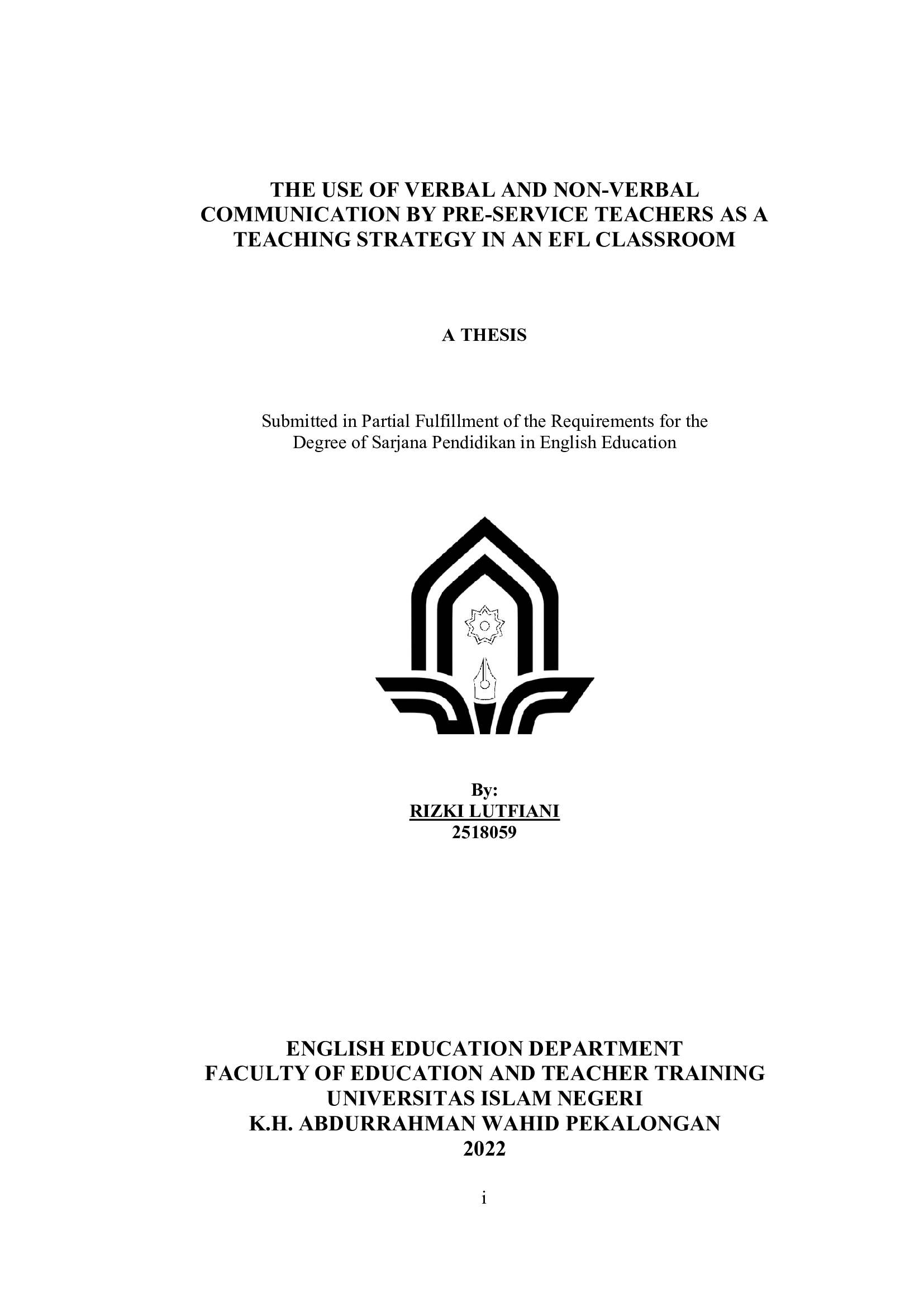
SKRIPSI TADRIS BAHASA INGGRIS
THE USE OF VERBAL AND NON-VERBAL COMMUNICATION BY PRE-SERVICE TEACHERS AS A TEACHING STRATEGY IN AN EFL CLASSROOM
The purpose of this study was to find out the use of verbal and non-verbal communication by pre-service teachers in the EFL classroom and how it affects students. This study uses a qualitative descriptive method with a case study approach. The data collection in this study uses observation, documentation, and interview methods. The participants in this study consisted of two male, and two female students majoring in English education at one of the universities in Pekalongan who are conducting teaching internship programs in two different senior secondary schools around Pekalongan area for 45 days, with a total of 4 videos. The data analysis from this research uses interactive data analysis techniques by Milles and Huberman which consists of four data analysis processes; data collection, data reduction, display data, and drawing conclusions. The findings show that all categories of verbal communication as mentioned in the FLINT system had been applied by the participants; dealing with feelings, praising or encouraging, using ideas of students, giving questions, giving information, giving directions, and criticizing student behavior. Meanwhile, nonverbal communication found includes facial expression, gesture or body language, posture, eye contact, appearance, personal space or proxemic, and voice or paralinguistics. The use of appropriate verbal and nonverbal communication as a teaching strategy can have a positive effect on students, and make learning be more effective and communicative.
REFERENCES
Ahmadi, I.K. (2011). Strategi Pembelajaran Sekolah Terpadu. Prestasi Pustaka Publisher
Ametembun, N.A. (1981). Supervisi Pendidikan: Penuntun Bagi Guru, Penilik, Pengawas, Kepala Sekolah. Suri
Andersen, P. A. (2007). Nonverbal Communication: Form and Functions. Waveland Press
Anjali, H., & Emmanuel, H. (2015). Kinesics, Haptics, and Proxemics: Aspects of Non-Verbal Communication. Journal of Humanities and Social Science. 20 (2), 47
Barabar, A., & Caganaga, C. K. (2015). Using nonverbal communication in EFL classes. Cypriot Journal of Educational Sciences, 10(2), 136-147.
Badriyani, N. U. (2018). Pengaruh Penampilan dan Gaya Mengajar Guru di Kelas terhadap Motivasi Belajar Peserta Didik di MAN 1 Madiun Tahun Pelajaran: 2017/2018 (Doctoral dissertation, IAIN Ponorogo).
Bell, J. (2006). Doing Your Research Project. Indeks
Brown, H. D. (2001). Teaching by Principle and Interactive Approach to language pedagogy. Longman Inc.
Brown, H. D. 2007. Principles of Language Learning and Teaching. Longman
Calandra, B., Brantley-Dias, L., Lee, J. K., & Fox, D. L. (2009). Using video editing to cultivate novice teachers’ practice. Journal of research on technology in education, 42(1), 73-94.
Cook, V.J. (2000). Linguistics and second language acquisition: one person with two languages. In Aronoff, M., and Rees-Miller, J. (eds) The Blackwell Handbook Of Linguistics. Blackwell
Dimbleby, R., & Burton, G. (2020). More than words: An introduction to communication. Routledge.
Elismawati, E. (2015). Classroom Interaction Analysis in the EFL Speaking Class: A Study at English Department of IAIN Imam Bonjol Padang. Polingua: Scientific Journal Of Linguistics, Literature And Language Education, 5(1), 25-32. DOI:10.30630/polingua.v5i1.21
Ketersediaan
| 23SK2325008.00 | SK TI 23.008 RIZ t | My Library (Lantai 3. Local Content) | Tersedia |
Informasi Detail
- Judul Seri
-
-
- No. Panggil
-
SK TI 23.008 RIZ t
- Penerbit
- Pekalongan : Jurusan S-1 Tadris Bahasa Inggris FTIK UIN K.H. Abdurrahman Wahid Pekalongan., 2022
- Deskripsi Fisik
-
xiii, 76 hlm., 30 cm; Bibliografi: 77-80
- Bahasa
-
Indonesia
- ISBN/ISSN
-
-
- Klasifikasi
-
371. 3
- Tipe Isi
-
-
- Tipe Media
-
-
- Tipe Pembawa
-
-
- Edisi
-
-
- Subjek
- Info Detail Spesifik
-
-
- Pernyataan Tanggungjawab
-
Rizki Lutfiani (2518059)
Versi lain/terkait
Tidak tersedia versi lain
Lampiran Berkas
Komentar
Anda harus login sebelum memberikan komentar
 Karya Umum
Karya Umum  Filsafat
Filsafat  Agama
Agama  Ilmu-ilmu Sosial
Ilmu-ilmu Sosial  Bahasa
Bahasa  Ilmu-ilmu Murni
Ilmu-ilmu Murni  Ilmu-ilmu Terapan
Ilmu-ilmu Terapan  Kesenian, Hiburan, dan Olahraga
Kesenian, Hiburan, dan Olahraga  Kesusastraan
Kesusastraan  Geografi dan Sejarah
Geografi dan Sejarah